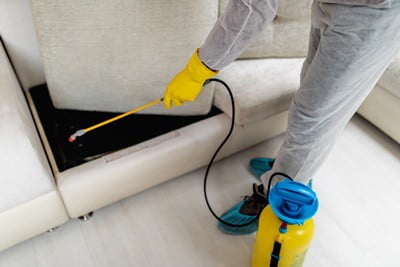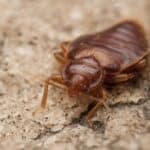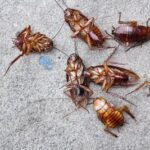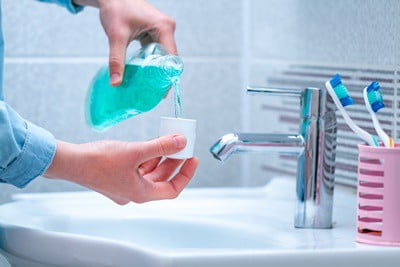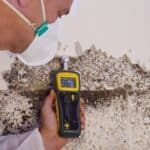To avoid human detection, roaches hide wherever they can find safety, preferring to come out at night when it’s dark for food and water. If roaches see furniture near resources, they’ll hide in that location.
Cockroaches may hide in furniture such as closets, dressers, chests of drawers, bathroom cabinets, or mattresses. These aren’t the most common places for roaches to live, but they make a good base for reaching the kitchen and bathroom for food and water. If the furniture is quiet and dark, roaches will lay their eggs.
Cockroaches hide in places that offer warmth and darkness. So, kitchens and bathrooms where water and food are close by are their favored places to live. However, if the furniture is nearby and easily accessible, cockroaches will hide there until they can find somewhere more suitable.
Do Cockroaches Hide In Furniture?
Cockroaches have the ability to hide in the smallest spaces. According to PNAS, cockroaches can get in almost anywhere due to their soft-bodied, shape-changing ability.
They can also traverse horizontal crevices smaller than a quarter of their height. They do this by compressing their exoskeletons. They move from one place to another at 20 body lengths per second, even in vertically confined spaces.
Unfortunately, this makes it easy for cockroaches to get into furniture, including couches, dressers, and cabinets. Cockroaches like places that are:
- Warm
- Dark
- Quiet
- Sheltered
- Away from predators
- Humid or easy access to water
While furniture isn’t the favored choice for cockroaches to live, they will reside inside pieces of furniture that make them feel safe, only leaving when the time comes to find food and water. However, if the furniture is regularly used, roaches aren’t likely to remain for too long. Cockroaches will hide in:
- Closets
- Dressers
- Drawers
- Couches
- Beds and mattresses
Couches, in particular, harbor food crumbs that cockroaches feast on. Because couches are regularly used, it’s more likely that they will scavenge for food down the sides of the furniture before returning to their permanent home.
Also, because cockroaches prefer moist places to hide and breed, they choose furniture that gives them easy access to areas with water and food. Roaches in used furniture are more common, as old wood is a food source and means they don’t have to go scavenging as often.
In most modern homes with open plan living arrangements, the couch is likely to be near the kitchen. Similarly, dressers and closets are usually located in the bedroom close to the bathroom. Roaches will make supply runs to these areas to get what they need, so much of your furniture is ideally positioned for these resilient pests to survive.
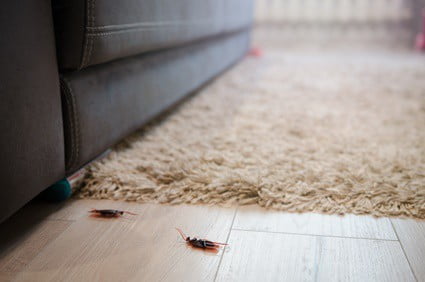
How To Tell If Cockroaches Are In Your Furniture
Unfortunately, cockroaches are quiet and tuck themselves away in the tightest spaces. It isn’t easy to know whether cockroaches live in furniture unless you’re actively looking for them. However, there are other signs to look out for that can give them away. Check for the following:
Feces
When you’re inspecting your furniture, look out for tiny black or brown dots that look like coffee grounds. If your cockroach is active inside your furniture or visits regularly, feces will be present. Large amounts of poop mean that there’s likely to be many cockroaches present.
Don’t leave any feces behind. Roach poop contains proteins that can trigger a range of health problems, including respiratory conditions, diarrhea, and asthma. Vacuum or sweep up the feces up and disinfect the area. Ensure that you wash your hands thoroughly when you’re done, as cockroach droppings are harmful to humans.
Unpleasant Odors
If you have a large roach infestation, you may notice an unpleasant odor caused by the secretions that roaches produce. As explained by the US National Library of Medicine, roaches spread foul-smelling pathogenic agents. Over time, the odor worsens until you can easily detect it around your home.
The reason cockroaches smell so bad is because they store uric acid in their fat. They also give off pheromones to communicate with other roaches. Dead cockroaches smell even worse because their carcasses emit oleic acid, also known as the “death stench.” This smell is used to warn other roaches about nearby dangers and hazards.
Eggs Cases
Another sign of a roach infestation inside furniture is egg cases. Cockroaches lay an average of 16 eggs at a time, all of which are contained in one casing called an ootheca.
Roaches deposit the ootheca in warm, sheltered locations where they can’t be harmed. Furniture makes the ideal home for a pregnant female‘s eggs. People rarely inspect the backs of furniture, meaning that eggs are less likely to remain unharmed. So, check your drawers, closets, dressers, and beds for signs of egg cases.
Stains
Cockroaches leave behind brown smear marks on furniture, especially if water is present. The marks are usually long and irregularly shaped. They’re sometimes raised from the surface. Wipe these stains off using a disinfectant but be careful not to touch them with your bare hands because they contain harmful pathogens.
Do Cockroaches Eat Furniture?
Cockroaches won’t eat plastic furniture as it’s not an organic food source. However, rotting and decaying wood can be part of a cockroach’s diet. Of course, old, antique, or used furniture is more likely to rot or decompose.
Decaying wood is softer and easier to eat. Roaches can digest cellulose, allowing them to eat wood and other tree-based matter, such as paper and cardboard. Unfortunately, this means wooden furniture can be a source of sustenance. Roaches can eat paint, so treat wooden furniture with varnish.
When cockroaches get into beds and mattresses, they may eat the fabric. However, roaches are more likely to eat the dead skin cells and hair that you shed. Also, if you eat food in bed, roaches will find and eat those crumbs.
Do Cockroaches Lay Eggs in Furniture?
Cockroaches lay eggs in tight spaces for safety. The benefit is that it can be dark, especially down the back and in the corners. Humans can’t see roach eggs without shining a light shining into those areas.
Be careful when bringing new or pre-owned (second-hand) furniture into your home. If boxes are left out for too long, roaches may seize the opportunity to get inside to live and lay their eggs. Similarly, if you’re moving home, check any boxes before putting furniture into them and again before you bring them into your new home.
How To Get Rid Of Cockroaches In Furniture
It’s not a pleasant thought that cockroaches could be living in the furniture you use. It’s also unhygienic, as cockroaches harbor a range of dangerous diseases that make humans ill. If you’ve found a roach infestation, you must prevent it from worsening. To do so, you’ll need to clean all aspects of the home, starting with your furniture.
Couches And Sofas
Crumbs fall down the cracks of couches and sofas, encouraging roaches to go after them once they detect that food is nearby. Vacuum the couch, paying particular attention to the gaps where cockroaches are likely to be residing.
Remove and vacuum the cushions. For cushions with zips and padding inside, remove the padding and turn the cover inside out. If your cushions are machine washable, follow the washing instructions. The heat from the water will kill cockroaches and their eggs. However, if the cushions will shrink in the wash, proceed with vacuuming.
Tip the couch over and vacuum the underside as roaches are most likely to reside underneath where it’s safe and dark. Ensure you empty the vacuum bag or container and take it to the trash to stop cockroaches from returning.
Wash your couch with an upholstery shampoo. Adding 1/2 cup of white vinegar to the solution helps drive out cockroaches from their hiding spots and deters them from returning.
Natural roach bait is safe to be placed around the couch. Mix 1/4 cup vegetable shortening, 1/8 cup white sugar, 1 cup boric acid powder, ½ cup flour, and a little water. Stir all the ingredients together to create a soft dough.
Roll the mixture into small balls and place them into empty yogurt pots. Cover the pot opening with a lid and make a hole that’s big enough for cockroaches to get through with a pair of scissors.
Cockroaches will enter the hole, eat the mixture, and poison themselves. They will then go back to their colony, where the poisoned roach will die. Other cockroaches will feast on the dead body and die from the poison.
Drawers, Dressers, And Closets
Closets, drawers, and dressers are dark and make a good hiding spot. Ones that are made from wood, metal, or plastic are easy to clean. They can be washed inside and out with a soap solution mixed with warm water.
To create your solution, fill a spray bottle with dish soap and warm water and spray directly onto the furniture. Use a towel or dishcloth to wipe the solution off.
The furniture will need to be treated with a spray or gel bait to kill the roaches. Use the bait a couple of times a week until the roach problem is removed. Wash the clothes that were inside the drawers or closet to remove any eggs. Wash the clothes on a high heat setting to kill all roaches and eggs.
Bathroom Cabinets
Bathroom cabinets placed underneath sinks to hide pipes and drains are attractive to cockroaches. Surprisingly, cockroaches eat soaps, toothpaste, and toilet roll, as all these items contain digestible starch.
To prevent roaches from getting into bathroom cabinets, seal up all cracks and gaps with caulk or plaster. You can also block drains with rubber covers that prevent them from gaining entry.
Fixing leaky drains and faucets will repel cockroaches. When it comes to the cabinet itself, keep it dry and store soaps and other starch-based items in tubs.
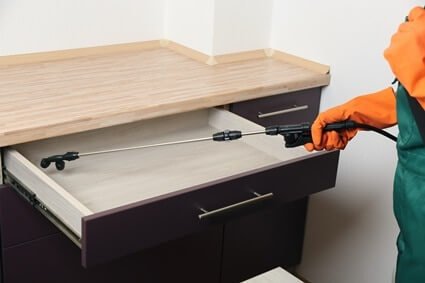
Beds And Mattresses
While it is unlikely cockroaches will set up home in the bedroom as there’s usually not much food available, a mattress makes a warm place to hibernate if there’s no better alternative.
Cockroaches can get in through gaps and rips, so once you’ve treated the mattress, be sure to patch them up to stop any more from entering. Small rips can be stitched, while larger gaps can be covered with fabric patches.
Boric acid is one of the most effective forms of pest control. Sprinkle a light dusting around your bed. When cockroaches come into contact with it, they will eat it and die. As cockroaches feed on dead cockroaches, the rest of the colony will also consume the poison and die. Boric acid is an effective way to remove large infestations.
If you’d prefer a more natural form of pest control, diatomaceous earth kills roaches by scratching their exoskeletons as it has sharp edges. It absorbs the oils and fats from the body, drying the roaches out and killing them.
How To Prevent Cockroaches in Furniture
Get a mattress topper so that you don’t come into contact with any cockroaches or their eggs. Some people prefer to get a new mattress altogether, but the infestation still needs to be dealt with first.
To repel cockroaches naturally, spray cypress and peppermint oils around your bed. You can create a solution by mixing 8 drops of cypress oil or 10 drops of peppermint oil with 1 cup of water in a spray bottle.
Spraying the mixture every morning and evening will be enough to keep cockroaches away. You may not want to overdo it as the scents are quite potent and may disturb your sleep when you move back into your bedroom.
Furniture is rarely the source of the infestation but an indication that there is one. Cockroaches will live in all corners of the home, so you may find a roach nest in various places.
